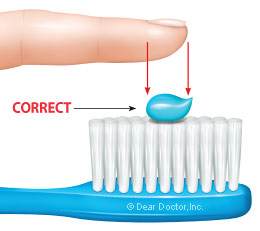Managing Tooth Decay In Children With Chronic Diseases
Poor oral health puts kids with special needs at risk
(Continued)
Chronic Disease and Tooth Decay
Tooth decay is a major cause of tooth loss in children. Acidogenic (acid-producing) bacteria make acids from sugars in the diet that cause tooth decay. These bacteria, which live in the biofilm that collects on the teeth, are commonly transmitted from mothers to their children through everyday activities such as sharing utensils, kissing or even licking the child's pacifier. Mothers with untreated tooth decay are more likely to infect their children. Others in poor oral health and in close contact with the child — siblings, relatives, caregivers, babysitters, and daycare workers — can infect the child as well.
The bacteria that cause decay thrive on a child's diet that is rich in carbohydrates. Examples are bread, rice, crackers, candies, sweets, honey, sodas, sports drinks, and fruit juices. Sweetened medications and nutritional beverages and shakes that many children with chronic health conditions take regularly are high in sugar content and are acidic as well.
Consuming these carbohydrate-laden foods more than a few times per day outside of mealtimes creates an environment that both attracts acid-producing bacteria and allows them to multiply more rapidly. More importantly, the constant acidity created overwhelms the ability of the saliva to buffer the acid and neutralize it, which normally takes about an hour. Thus hourly sugar-laden medicine or sugary snacking means the mouth is always acidic. This leads at first to tooth “demineralization,” the dissolution of the enamel on the tooth surface creating white spots. This early sign of decay is reversible; teeth can be “remineralized” with acid reduction and adequate exposure to fluorides.
Well-defined mealtimes with limited snacking, preferably on non-carbohydrate foods, plus not allowing children to snack and drink beverages all day, allows time for the saliva to help neutralize acid and return the mouth to normal. Unchecked, white spots will eventually progress to tooth decay.
|
Correct amount of toothpaste for Children |
| Children commonly use more toothpaste than the recommended amount on their toothbrush. Too much toothpaste increases the chances of your child consuming too much fluoride. |
 |
| Figure 1: The above illustration shows the proper amount of toothpaste for a child, which is a pea-sized amount or roughly the size of their fingernail. |
 |
| Figure 2: The above illustration shows the incorrect amount of toothpaste for a child. This amount could be swallowed by the child increasing or exceeding the daily amount necessary. |
Special Care For Special Needs
All children should have a first dental visit by their first birthday. The Age One Dental Visit ensures that the child has a “dental home” in which preventive care is provided regularly and restorative care can be instituted when necessary. In cases where tooth decay is already present, dental restorative treatment techniques can be utilized to minimize discomfort and eliminate the need for local anesthetic. These techniques are quick and effective — particularly helpful in treating children with chronic health conditions.
FluorideFluoride is a naturally occurring element that strengthens tooth enamel during its development when it is incorporated into the enamel's structure, making it more resistant to acid attack. Fluoride also increases resistance when applied topically to the surfaces of the teeth. The most cost-effective fluoride delivery system comes in the form of community water fluoridation. About two-thirds of the U.S. population lives in communities with fluoridated water supplies. The recommended amount of fluoride in water supplies is 0.7 parts per million — a very small amount that goes a long way.
Fluoride is the active ingredient in toothpaste. Brushing your child's teeth with a fluoridated toothpaste is effective in preventing tooth decay. You should use just a smear for children under age 2 and a pea-sized amount for children age 2 and older. Any brand will do, especially if it carries the American Dental Association (ADA) seal of approval. Side effects only occur when children are allowed to habitually lick, eat or swallow flavored toothpaste. Brushing with fluoridated toothpaste twice per day is more effective than brushing once per day. Children can brush their teeth themselves when they get older but need to have adult supervision.
Fluoride varnish is commonly applied to children's teeth in dental and medical clinics. Two to four fluoride varnish applications per year has become the standard of care.
While helpful, fluoride alone is unlikely to prevent tooth decay in children who are heavily infected with decay-causing bacteria and have a bad diet.



